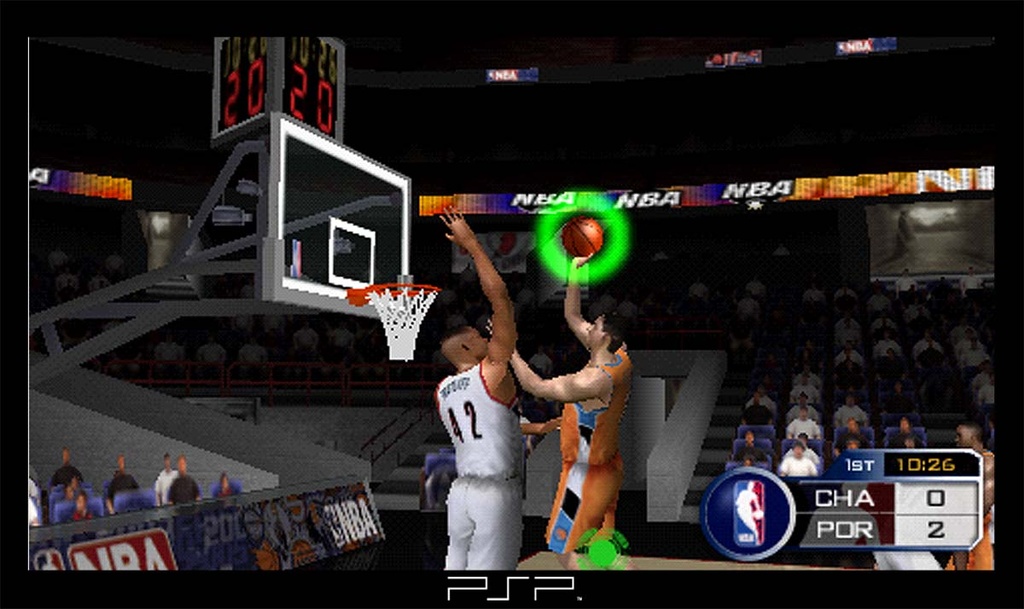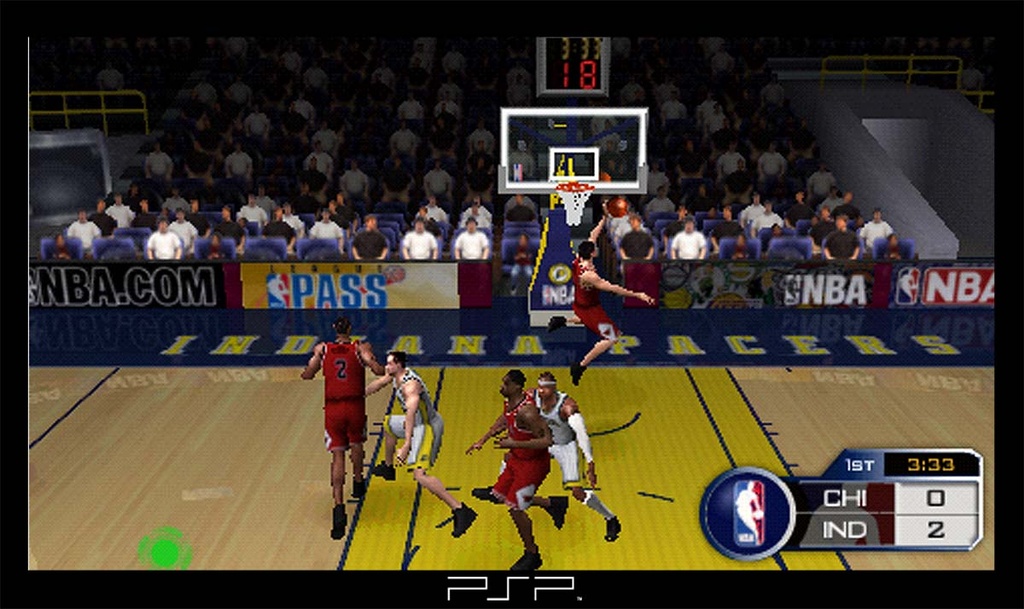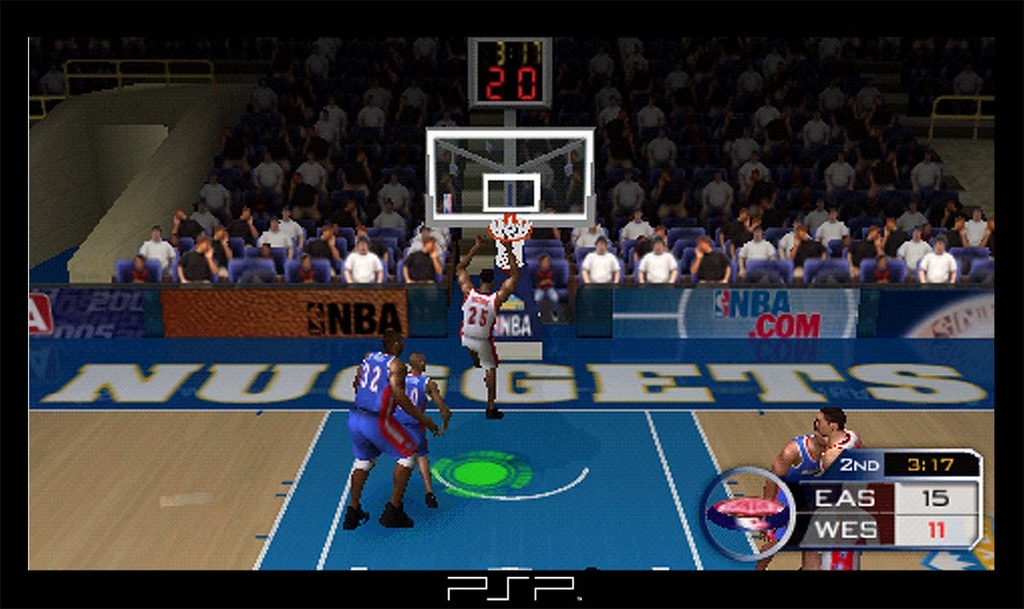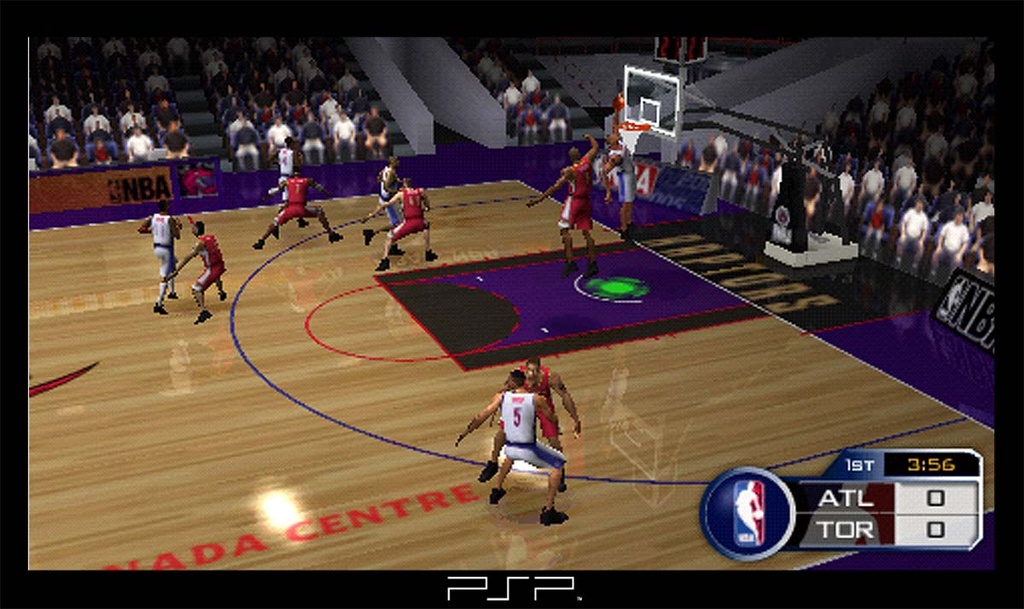As a basketball game developer, 989 Sports has been riding the pine for a while. After the unmitigated disaster that was NBA Shootout 2004 on the PlayStation 2, 989 sent itself to the bench in order to regroup several of its sports franchises. NBA for the PSP represents the developer's roundball comeback. And while NBA is a definite improvement over 989's last hoops effort, there's still a great deal of improvement left to make. NBA offers a number of different play modes and minigames, as well as full Wi-Fi networking support for one-on-one action. Unfortunately, the core gameplay in NBA is lackluster in presentation and execution, making it difficult to recommend to anyone but the most hardcore basketball fanatics dying for a portable fix.

The controls in NBA are pretty basic. You move your player around using the control disc. Shooting, stealing, blocking, and passing are mapped to single button presses, although strangely enough, there is no turbo button in this game. You can, however, use other button combinations to execute jukes like jab steps, crossovers, pump fakes, and spin moves. Though, these fakes aren't all that useful, and since they simply unleash canned animations, they can be somewhat hard to control. If you try to get too fancy while you're close to the sideline, for instance, you're more likely to spin your player out of bounds rather than get by your defender.
You also have access to a simple playbook by tapping on the D pad, but as these plays are only vaguely described in the manual, it's difficult to figure out exactly how the motion is supposed to run and who you're supposed to pass the ball to. Defensive play calling doesn't have much of an effect at all. It doesn't make much difference though, as the opponent artificial intelligence on both sides of the ball isn't all that difficult to beat. Just passing the ball or dribbling around with your fastest guard is usually enough to free up for an open shot. Computer opponents also make some boneheaded moves on offense, like hoisting up deep, 30-foot bombs early in the shot clock or dribbling the ball out of bounds.
One thing that will take some getting used to is the high number of blocked shots you'll see on jumpers in this game. If your defender has any kind of position on you at all while you take a perimeter shot, he will try to swat at the ball, which ends up feeling rather unrealistic. Eventually you'll adjust to the game and get a feel for what kind of positioning you need to get your shot off, but it's still annoying to see so many unrealistic blocked shots on both sides of the ball.
The most unique aspect to the gameplay in NBA is its unique shooting system. Whereas most basketball video games stick with the tried-and-true "hold and release at the top" method of shooting, NBA requires two button presses. The first tap on the shoot button causes the ball handler to jump up in the air. You'll see a colored halo around the ball, which will change color to give you a cue as to when you should press the button again to release the shot. Red means a low shooting percentage, yellow is a bit better, and green gives you your best chance to hit the shot. If you're well defended, sometimes you may not even see the halo change to green, so in the end it's best to just try to release the ball at the apex every time. Conversely, getting a green halo doesn't mean your shot is guaranteed to go in either.

While it's nice that the developers have tried to shake up a long- held convention of basketball games, the new shooting method ends up feeling more awkward than innovative. Forcing you to press the button twice makes it difficult to get off quick, buzzer- beating shots. The overall slowness of the process is also unnatural, because NBA-level shooters are trained to release the ball quickly. Another part of this awkwardness stems from the puzzling way in which the game handles dunks and layups. If you drive to the basket with a player and press the shoot button, you'll usually unleash one of the game's few dunk animations, which doesn't require a second button press. Layups do require a second button press, but since the jumping animation for these happens so quickly, you're liable to miss out on the right moment to finish the shot. This can be frustrating from a logical standpoint, because layups ought to be easier than jump shots. But, like the shot-blocking AI, you'll eventually get used to it.
There are a few basic game modes in NBA, including quick play, minigames, and season mode. The quick play or exhibition mode allows you to select any of the 30 NBA teams, the two conference all-star teams, Team USA, or the six NBDL teams, whose in-game rosters are stocked with fictional players. The NBA team ratings appear to coincide with each team's performance in the current NBA season, so you'll see the Spurs, Suns, and Sonics with top ratings, while bottom-dwellers like the Bobcats, Jazz, and Hawks have very poor ratings.

The season mode lets you play out a single 29-, 58-, or 82-game season with any of the NBA teams, and you can also lead a charge into the play-offs if you play well enough. You can simulate or play any game you wish while checking standings and injury reports in the very basic management menus. You can execute trades as well, but there is no trade logic included in the game, so it's easy to stack your team with superstars while getting rid of all your benchwarmers. While playing as the Lakers, for example, we dumped journeymen Chucky Atkins and Chris Mihm for superstars Steve Nash and Amare Stoudemire. The Suns happily accepted.
NBA offers three minigames, including a three-point competition, a skills challenge, and a special mode called "paint," which can be played against the computer or a human opponent in the game's Wi-Fi networking mode. The three-point shoot-out is a simple shooting minigame, while the skills challenge involves running a player through a timed obstacle course that includes shooting, dribbling around pylons, and passing balls through targets. Paint is a simple game that involves two players on the court. Each player tries to claim a section of the court (each of these sections is assigned a point value) by making a shot from that area. The last player to sink a shot from a specific area has ownership of it. At the end of the time limit, the players' points are tallied, and the one with the most points wins. All the minigames are decent diversions, but none of them should make or break your purchasing decision.
NBA's graphics are vibrant and colorful, but as far as detail goes, it can still take some squinting to try to distinguish different players on the floor. Numbers on the backs of jerseys are barely readable, for example. The developers have thoughtfully tried to make players look more unique via accessories like headbands and braces on the players who wear them, and even by including Latrell Sprewell's ghetto Princess Leia hairdo. But given the constraints of the PSP's screen, it might have been better to offer other methods of player identification, like numbers above each player's head. Whenever you pull off a spectacular play, the game pauses briefly and zooms in on the player's face, framing it in a collector's card-style action shot. From here you can see the detail that went into modeling each player's face, and for the most part, the artists have done a good job. However, this pausing and zooming in on highlights can get annoying and distracting after a while. The game's animation could also use some improvement, as players run very stiffly, and there isn't much variety in the dunk and layup animations.
NBA's sound effects are probably on a par with its graphics, which is to say, they're not that great. There's a generic buzz of crowd noise and applause. The sounds of the game, like the bouncing of the ball on the court or sneakers squeaking on the court, are absent or drowned out by the annoying stadium music that's piped in during the game. The loudest court sound you'll hear is the ball rimming out or swishing through the basket after shots. No play-by-play announcing or narration is included, aside from the stadium announcer calling out fouls and out-of-bounds.

The most compelling feature in NBA is arguably its Wi-Fi networking capability. NBA ships with both ad hoc (local) and infrastructure (Internet) modes to support two players. The multiplayer support works pretty well and should provide players with frequent competition, but the core gameplay isn't strong enough to make this feature as exciting as it could be.
Even though NBA does offer wireless head-to-head play, several game modes, and the unique advantage of being the only hoops game to ship with the PSP, these features are really all the game has to offer. Its core gameplay is decent, but roundball fans with more discerning tastes are sure to find plenty of faults with the game and likely won't be satisfied. NBA also makes a nice effort at trying to stand out with its unique shooting mechanic, but the two-button-press method of shooting just ended up being too awkward and unintuitive to be considered a plus. Unless you're absolutely set on having a basketball game to play on the go, you're probably better off waiting for better hoops offerings to come along on the PSP.